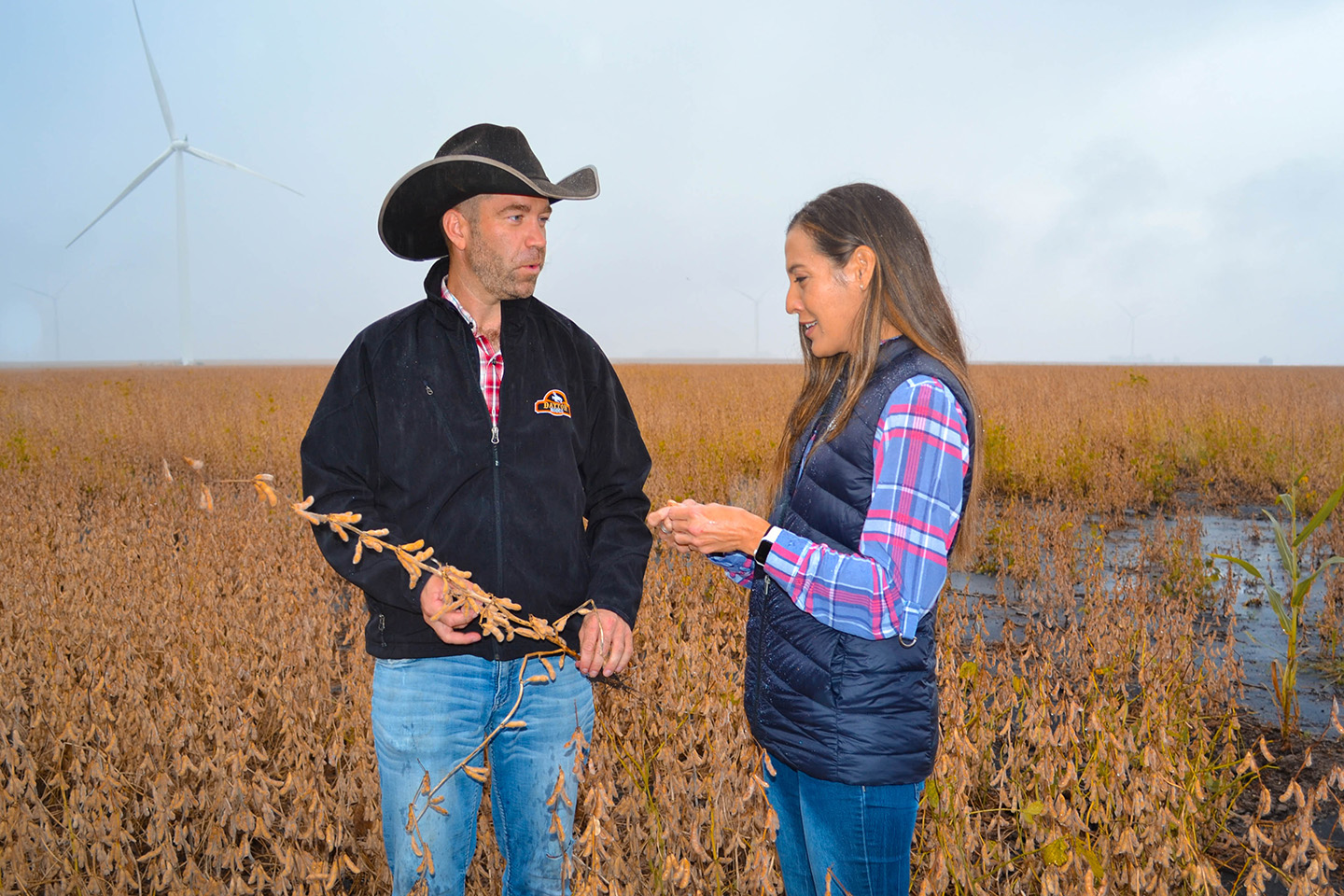
Hawaii State Rep. Val Okimoto saw soybean for the first time on the Green family farm near Harcourt last weekend. (Photo: Kriss Nelson/Iowa Soybean Association)
A look at Iowa agriculture
October 6, 2021 | Kriss Nelson
From the Iowa State Capitol, a hot air balloon ride and some farm visits, Hawaii Representative Val Okimoto got to see firsthand what Iowa is all about. This included seeing a soybean field for her first time.
Okimoto met with Iowa State Sen. Jesse Green (R-Harcourt) while visiting the mainland last week. Green is a fifth generation farmer born and raised just outside of Harcourt. The Iowa Soybean Association farmer member grows soybeans, corn, oats, hay and raises bucking horses for rodeo and riding purposes, and longhorn cattle for roping with his family.
Both took the networking opportunity with open minds, listening to each other’s concerns about their respective states, including agriculture.
“It is interesting to find like-minded people. Jesse and some of the other legislatures have been very kind in welcoming me,” said Okimoto, adding she considered this a pre-trip as she and her staffers have interest in attending the Iowa State Fair.
Diversifying the economy
Although Hawaii was once known for its agricultural presence, its main revenue sector today is tourism.
“When Hawaii was a territory, before we became a state, we were actually ag-based,” said Okimoto. “My grandfather was a Filipino immigrant who worked on the sugarcane plantations back when our state was based on sugarcane and pineapple — that was the economy.”
The Hawaii government has land set aside specifically for agriculture. Okimoto said she would like to see those areas become more diversified as Hawaii’s reliance on tourism was shaken with the COVID-19 pandemic.
“We found out we are so tourist heavy,” she said. “We will always continue to be, but I would creatively like to bring ag back. Some people think we should go back completely to agriculture. I don’t think that is realistic, but if there is a way we can incorporate tourism with ag — that is something worth looking into.”
According to Hawaii’s Department of Business, Economic Development and Tourism, the number of visitors plummeted from 995,210 in July 2019 to 22,574 in July 2020.
When tourism slowed in Hawaii, farmers were left with an overabundance of food they were not able to sell to hotels and restaurants.
Okimoto said COVID-19 forced farmers to find creative ways to move their products.
“They got creative; they went door to door. They created their own niche market. They created sort of an Uber Eats where they worked with a chef using their products and brought them to consumer’s homes,” she said. “That is really when I realized how much COVID affected our farmers. The farmers were really struggling.”
An Iowa experience
Okimoto said she wanted to visit Iowa and learn more about the state’s ag sector.
“I love to learn as much as I can to see what I can take back and help my state,” she said.
One specific topic Okimoto and Green discussed was the controversy surrounding GMOs and pesticides.
“With GMOs, some accept it, some don’t — even within the ag community, but it is a big controversy,” said Okimoto. “I have learned your stances on GMOs are opposite of ours.”
Green was looking forward to getting Iowa's ag story back to the people of Hawaii — specifically their government.
“The whole country is talking about how we can become greener,” he said. “I want to make sure it is known biofuels have a place at the table for green energy. The more connections around the country we can make to ensure it is on people’s minds the better.”
Another message? Come visit Iowa.
“Most people don’t think of Iowa has a tourist spot, but I think when people come to see Iowa, especially in October — although I haven’t been to Hawaii — I would guess it (Iowa) is one of the most beautiful places in the world,” Green said.
Green has started his second year serving Iowa’s 24th District and has enjoyed meeting people like Okimoto.
“The biggest eye opener for me has been the networking and people you meet and doors of opportunities that come open,” he said. “Just seeing the world from so many different lenses — just in Des Moines has been fascinating, let alone a five-hour time zone difference. That has shaped me in so many ways and I am forever grateful for these experiences.”
Back